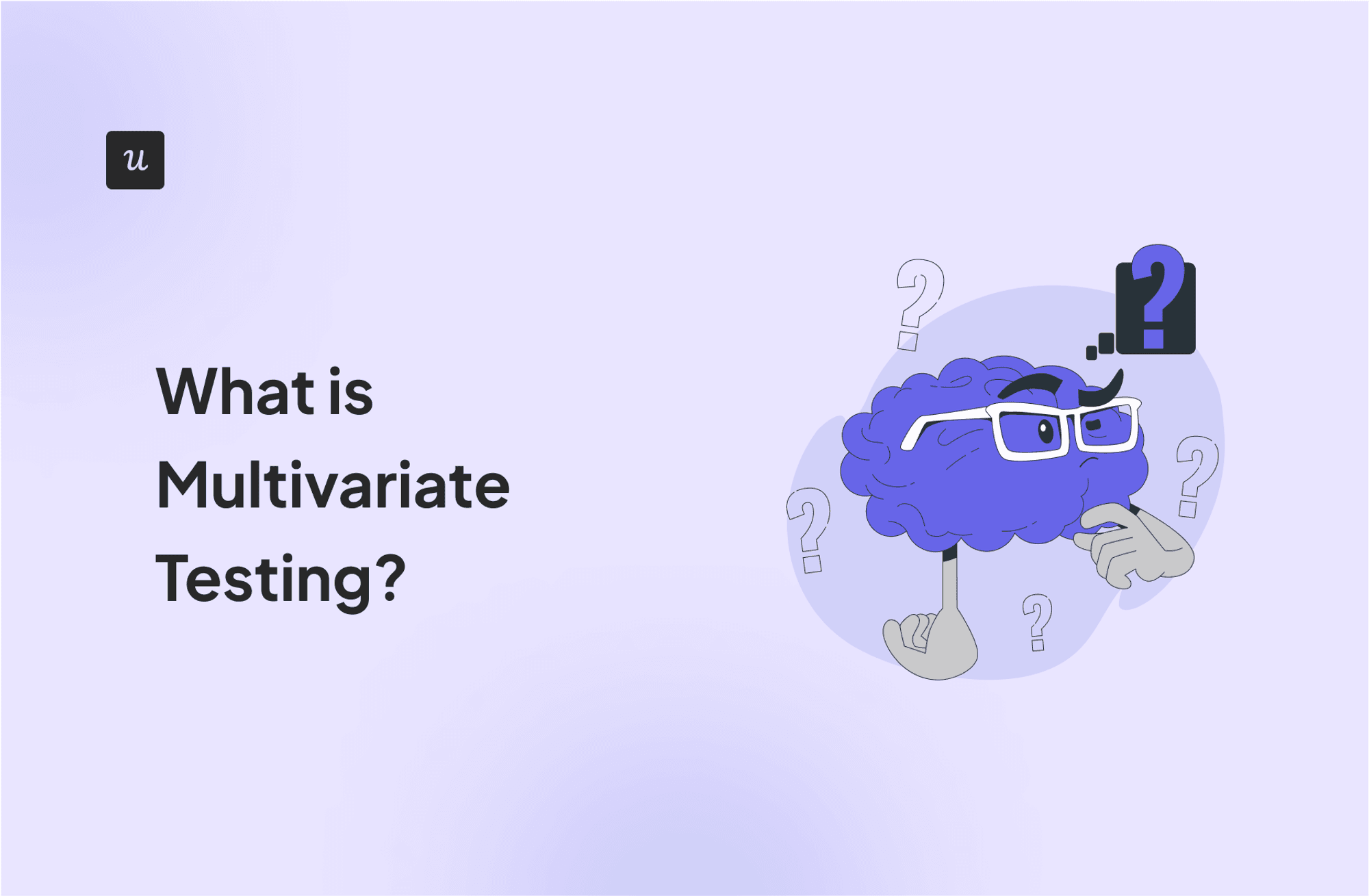
Try Userpilot Now
See Why 1,000+ Teams Choose Userpilot

What is multivariate testing?
Multivariate testing (MVT) is a method of experimenting with multiple variables on a web page or app to determine the best combination that leads to the highest conversion rates or desired outcomes.
MTV helps you test your hypothesis before rolling out significant changes, reducing risk and improving your bottom line.

Multivariate testing vs A/B testing method
While multivariate tests are similar to A/B tests in many ways, there are key differences between them, and understanding these will help you choose the best method for your needs.
- Number of variables: The multivariate method lets you test multiple variables simultaneously (e.g., headline, image, CTA), while A/B testing involves only two variations at a time (e.g., a control headline and the variation).
- Setup requirements: A/B testing is simpler to set up and analyze since only one element is changed and measured at a time. The results are straightforward, making it easier to attribute changes in performance to a specific element. Multivariate testing, however, is more complex to design, implement, and analyze due to the multiple combinations of changes.
- Use cases: An A/B test is best for experimenting with single elements and websites/apps with lower traffic. Multivariate tests are ideal for complex pages with multiple elements or high-traffic websites/apps with specific goals.
- Time to results: Multivariate testing generally takes longer to reach statistically significant results due to the complexity and traffic needs.
- Insight: While A/B tests simply show a single change’s impact, multivariate testing dives deeper into how different elements interact and which combinations perform best.
Benefits and disadvantages of multivariate testing
Let’s analyze what benefits and disadvantages multivariate testing offers:
| Benefits of multivariate testing | Disadvantages of multivariate testing |
|---|---|
| Comprehensive insights: MVT provides a deep understanding of how multiple elements on a webpage or app interact with each other. | Complexity: As previously mentioned, MVT is more complex to set up and https://userpilot.com/blog/analyze-customer-data/ than traditional A/B testing due to the numerous combinations of variations that need to be tested. It requires sophisticated tools and expertise. |
| Faster optimization: Instead of running several A/B tests one after another, multivariate testing evaluates all possible combinations simultaneously, streamlining the https://userpilot.com/blog/saas-user-flow-optimization/. | Cost: MVT can be more expensive than A/B testing due to the need for specialized tools and longer testing periods. |
| Reduced risk: MVT helps you validate hypotheses and understand the impact of changes before implementing them on a larger scale. This reduces the risk of making detrimental changes to your website or app. | High traffic requirements: MVT typically requires higher app or website traffic volumes to get statistically significant results due to the need to split traffic among multiple variations. |
| Improved decision-making: Detailed insights gathered from MTV can help you https://userpilot.com/blog/data-driven-insights/ about the design and content of your webpage or app, leading to better overall performance. | Potential for over-optimization: There is a risk of over-optimization, where focusing too much on the test results might lead to neglecting other important factors like https://userpilot.com/blog/customer-intent/ and broader https://userpilot.com/blog/improve-user-experience/. |
Multivariate test examples
In addition to understanding the benefits and drawbacks, it’s helpful to see how multivariate testing can be applied in real-world scenarios.
Let’s explore some specific examples:
Test different in-app onboarding approaches
Imagine you’re running a SaaS company with various pricing tiers (e.g., Starter, Growth, Enterprise) and want to create the best onboarding path for each plan.
You could employ multivariate testing.
By crafting tailored onboarding paths for each tier and analyzing user engagement, satisfaction, and long-term retention, you can identify the most effective paths for each customer segment.
This data-driven approach allows for continuous improvement, focusing on initial conversion, long-term success, and reducing churn across all pricing levels.
Test different visuals and texts on landing pages
Use multivariate testing to experiment with combinations of hero images, headlines, body copy, call-to-action buttons, and social proof elements.
By testing these variations, you can identify the most effective combination that resonates with your target audience and drives the desired action.

Test different modals for conversion rate optimization
Consider this: you created an in-app modal that prompts users to leave you a review on G2. Few users responded, but you’re not satisfied with the response rate.
To improve the results, you could run a multivariate test that compares the following variables:
- Design: Test different modal designs, such as full-screen overlays versus small pop-ups and varying color schemes.
- Text: Experiment with different texts, including headlines, body content, and CTA phrases, to determine which are the most persuasive.
- Triggers: Compare different trigger conditions, such as time-based triggers (after 10 seconds on the page) versus behavior-based triggers (when the user scrolls 50% down the page).
Analyze which combination of design, text, and triggers leads to the highest conversion rates and implement it for the rest of your audience.
How to get started with multivariate testing
Here’s a structured approach to help you successfully implement multivariate testing:
Identify a pain point among your customer base
The first step is to pinpoint a specific area within your website or app that needs improvement.
This involves gathering quantitative data through analytics tools like session replays and pairing the results with qualitative insights from surveys to gain a holistic picture of the user experience.
How to do it with surveys: Implement contextual feedback surveys that allow users to share their experiences. You can combine open-ended and closed-ended questions for a more comprehensive insight.

Formulate hypothesis
Once the pain point is clear, develop specific hypotheses about potential solutions. These should be testable and actionable.
For instance, you might hypothesize that trial users don’t fully understand your value proposition or are struggling to implement your software due to a lack of in-app guidance.
Your hypothesis statement would be: “By highlighting key use cases and providing personalized onboarding during the trial, we can increase the trial-to-paid conversion rate.”
Create test variations
Based on your hypotheses, design multiple variations for each element you’re testing. Ensure the changes are significant enough to have a measurable impact.
Example:
- First variation: Add a series of interactive tooltips that guide users through core features during the trial.
- Second variation: Introduce a personalized onboarding email sequence that offers tailored tips and best practices based on the user’s industry or role.
- Third variation: Create a video walkthrough demonstrating how the software solves common pain points in the user’s industry.
A true multivariate test involves testing different combinations of these variables. For example, you might test:
- Tooltips + personalized emails.
- Tooltips + video walkthrough.
- Personalized emails + video walkthrough.
- All three together.
- None of them (control group).

Determine your sample size
Before launching the test, you need to calculate the minimum sample size required for each variation to ensure statistically significant results. This depends on factors like your desired confidence level, statistical power, and the expected effect size of the changes.

Define the goal of the experiment
Clearly state what you want to achieve with the test. This could be the end result of increasing conversions, reducing bounce rates, improving user engagement, or any other relevant metric.
Having a well-defined goal will guide your analysis and decision-making process.

Analyze the results
Once you have collected enough data, analyze the results of your multivariate test. Compare the performance of each variation against your defined goal and identify the winning combination.
Userpilot displays test results in real time. You can visit the experimentation dashboard at any time and see what combination is winning:

Make the necessary adjustments
Based on your analysis, implement the winning combination of variations on your website or app. Returning to our example, if the interactive tooltips combined with personalized emails drive more onboarding completion, it’s time to roll that variation out to your audience.
💡 Don’t forget: Optimization is an ongoing process. After implementing the winning combination, continue to monitor its performance and iterate as needed. For instance, from continuous tests, you might notice adding checklists to your onboarding flow increases your conversion rate even more.
Conclusion
While it requires careful planning and analysis, the potential rewards make multivariate testing a worthy investment for any company looking to optimize its customer journeys.
Ready to get started with multivariate testing? Book a demo to discuss your needs.







